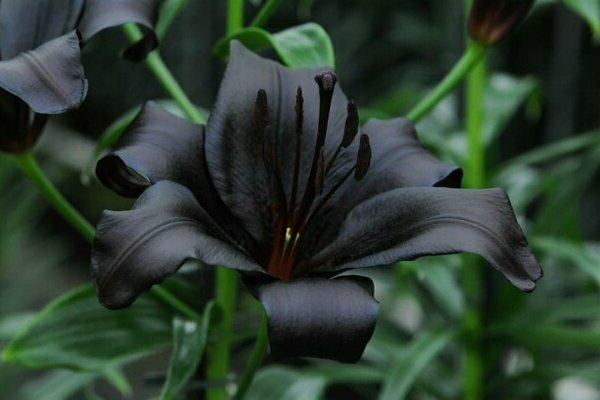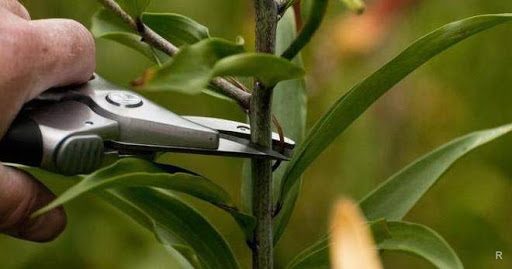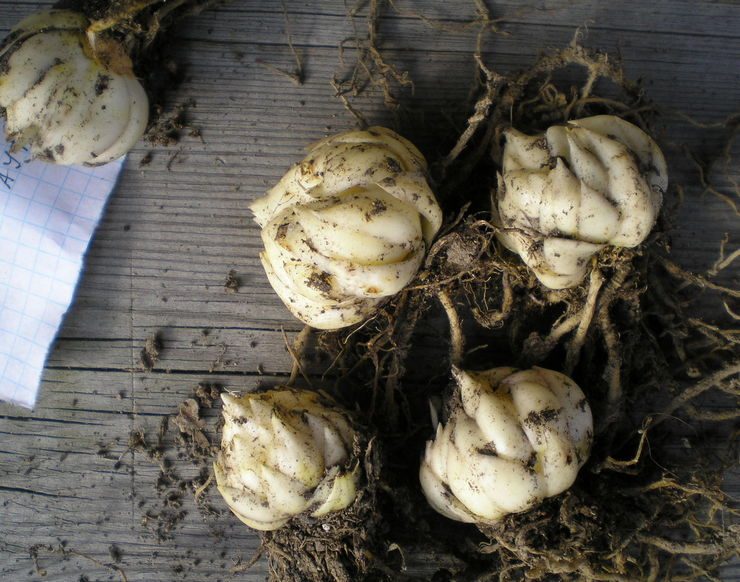Lily Pyramidal: planting and care
As a rule, pyramidal lily, like any others, is best planted immediately in open ground with bulbs. This is usually done in mid-spring, around May, when the soil has already warmed up to the required temperatures, and the chance that frosts return decreases to its minimum. If the gardener acquires seedlings and planting material in the fall, then the bulbs must be stored in a cool place until the beginning of May. A refrigerator is great for this.
So how to plant a pyramidal lily? The pyramidal lily bulbs are planted to a depth of twenty centimeters, no more. If the soil differs in that it contains a large amount of clay, then it should be pre-diluted with mineral components and fertilizers. Humus, peat or ordinary river sand are also excellent for these purposes. If we are talking about manure, then in no case should it be introduced in its fresh form - it is either calcined in an oven or frozen to kill all substances and microorganisms that can still live in it. Young bulbs, if placed in soil with fresh manure, can very quickly die from this, it is very dangerous, and experienced flower growers do not recommend taking such risks.
It is best to choose well-lit areas, as well as areas that are free from strong winds and drafts. If you plant a plant in unsuitable conditions, then it, of course, will grow, but there is a great chance that the buds will simply fall off, and this will lead to the fact that flowering will not take place at all. The distance between the beds of pyramidal lilies is at least ten centimeters.
How to care for a pyramidal lily for excellent flowering?
- watering lilies is necessary only in moderation, it is carried out by the root method. Do not allow water to fall on the leaves, otherwise the chance that a burn forms on the plant increases. Watering is necessary
- about 3-4 times a week, if precipitation is observed, then watering should be reduced. It is best to use settled water to add moisture.
- as for feeding, it should be applied exactly three times. The first time is done when the bulbs are planted, and the grower takes nitrogen fertilization. The second time, they usually take complex mineral fertilizers, which are excellent during the formation of buds and inflorescences. After the plant has bloomed, it is necessary to provide it with a feeding with a high content of phosphates and potassium, so that it is not depleted due to the fact that it has given all its nutrients and vital energy to the formation of inflorescences and their development.
- the soil must be periodically loosened so that it is ventilated, this is a necessary procedure for many crops, and especially for daylilies
- if the stem reaches its maximum height, it is best to tie the plant up. In case of windy weather without a garter, it will simply break and die.
- the bulbs must be replanted three times in one year. After the flowering period has passed, the daughter bulbs are babies, it is best to separate them from the mother ones. In the spring, children are also placed in the holes, they are treated and looked after according to the same scheme and according to the same principle.
Black lilies: varieties, description

These flowers instill mystery with their coloring. Also referred to as Asian hybrid varieties. Lilies are not entirely black in color, they are maroon or dark purple. But all the same, these flowers are full members of the black lily "community".
Variety "Landini".
It is the blackest lily to date. As the lighting falls, this will be the color of the flower - from dark burgundy to black and gray.
Mapira grade.
Very dark color, almost black. The growth of the stem is 130 cm. Flowering occurs at any time in the summer, it all depends on the mood of the weather.
Variety "Nightrider".
The lily is almost black in color, not completely Asian, more like something mixed from Asians and tubular hybrid varieties.
Variety "Black Out".
The name of the variety already wants to say for itself about the color of the flowers, but it wasn’t there - a lily of dark red color, has dark spots on the petals and a black core.
The most popular varieties of hybrids:
Lilies OT-hybrids
Abbreviation for Oriental - Tubular
Terry lily
Pretty Woman - (Lilium Pretty Woman). It grows almost up to a meter in height. Large inflorescences creamy white with a delicate pink.
Anastasia (Lilium Anastasia) Intricately curved leaves of a rich emerald color. Countless flowers of a bright pink hue, with a white spot at the base and a greenish stripe on it.
Robina (Lilium Robina) In a flowering hatch in a height of 1.5 m. Large green leaves with dark areas, Flowers purple-red with a yellowish core.
Scheherazade (Lilium Sheherazade). A giant variety of almost 2.5m. Multiple flowers of a reddish-burgundy hue, edging and a light cream-colored core. Blooms in late summer.
Honeymoon Large but delicate slightly yellowish flowers.
Shocking Pure red flowers are edged with a rather thick golden yellow stripe.
Lilies LA hybrids
Burgundy lilies
The abbreviation stands for Longiflorum Asiatic longiflorum
Frey or Freya (Fray) beautiful golden yellow flowers.
Ercolano (Ercolano) delicate inflorescences of lemon shades with white splashes.
California (California) exquisite cherry color large flowers with green stems.
Brindisi is a tall subspecies, growing 1-1.3 m. Large flowers not of a monochromatic pink color.
Fangio (Fangio) tall lilies up to 1.5-1.6 m. With a deep dark red beetroot color all over the petal.
Lilies A-hybrids
The abbreviation stands for Asiatic Lilies
Tiger
Tiger lily (Lilium lancifolium “Citronella”.) Or lanceolate. On a pure yellow background, orange-brown splashes are scattered, petals fancifully twisted outward.
Red Twin. Terry red lilies are not clouded in another tone of a pure shade, with stamens a little darker in color. Blooms early in June - July.
Fata Morgana from a row of yellow lilies. Terry soft yellow multiple flowers interspersed with brown dots in the neck. Blooms in late June or early July.
Ceres. The Asian lily is hybrid with a beetroot-crimson color, which is shaded in a light tone to the edge of a double petal.
Elodie. Double pink lilies. The pink tone lightens to the edge to pallor. In the center is a point of languid tone.
Lilies O-hybrids
The abbreviation stands for Oriental or Oriental Lilies.
Siberia white lily. Highly frost-resistant variety with snow-white inflorescences, with a slightly greenish center.
Lily Carolyn Tensen Huge snow-white inflorescences with a touch of some waxiness, looking slightly to the side. The foliage is light green.
Lilies LO-hybrids
The abbreviation stands for Longiflorum Oriental
Triumphator (White Triumphator), snow-white flowers with a crimson gradient in the center of swirling petals.
Lancon (lilium lankon). With drooping inflorescences of a beautiful pink shade with a large blotch on all petals of burgundy dots.
Lilies T-hybrids
Royal
The abbreviation stands for Tubular Lilies
African Queen has strongly curled orange petals, with darker spots on the outside. Dark emerald leaves.
Lily Royal Regale Album (Album) The flower is snow-white with a yellow core and richer yellow stamens. They do not grow tall, only up to 1 meter.
Pink Perfection Smoky lilac-pink large tubular inflorescences.
Damson Pink flowers with an unexpected shade of fuchsia on tall peduncles.
Rare lilies
Black Beauty (lilium black beauty). Purple tall lily more than 1.5m tall. On the surface of each petal, burgundy dots are scattered.
Lily Henry (henryii). A multi-flowered lily with numerous small flowers (about 7 cm each), orange-apricot in color, with a brown speck. A short "beard" grows at the base of each petal.
Scarlet Delight A rare beauty with burgundy flowers. A light green middle with a white edging comes out from each petal. The outer part of the petal is several tones lighter.
Dwarf lily
It also tolerates frost well, enchants with its miniature beauty and fragrant flowers.
Advice!
In order not to throw money down the drain, decide on the varieties that suit your region. For example, when choosing varieties of lilies for Siberia or for planting in the Urals, remember that Asian or LA hybrids will definitely be suitable, again with them at the base.
Growing and care
Growing lilies is usually fun and easy if you follow simple rules.
The soil
The quality of the soil affects the condition of the flower, the beauty and duration of flowering. In order for air to enter the roots, a loose substrate is needed. Lilies need nourishing, breathable soil. The acidity of the soil is selected, taking into account the type of plant: American grows well in acidic soil, tubular ones need a slightly alkaline substrate. Most species grow well in an alkaline environment.
Watering and mulching
Waterlogging of the soil leads to fungal diseases, lack of moisture inhibits growth, delays flowering. They irrigate the ground under the lilies twice a week, in the first half of the day, so that the moisture is better absorbed and retained longer. Watered with water warmed in the sun. By the end of flowering, the intensity of moisture is reduced, but on dry days, the root zone should remain slightly moist. For this, the soil is mulched with crushed bark or cut grass.

Fertilizers
Lilies grow quickly, so do not overload them with nitrogen fertilizers. Excess nitrogen will increase the growth of the "grass", and flowering will be scarce. When the first buds appear in the spring, organic matter is added once. After 3 weeks, they begin to feed with complex mineral fertilizers for bulbous. Do this until mid-July.
How to trim
Pruning lilies is needed to preserve beauty and as an incentive for future flowering. The procedure is carried out twice:
- after flowering, wilted buds are cut off, inhibiting development and impairing the appearance of the bush;
- in the fall, the lily is prepared for winter - the stems are cut, leaving hemp up to 0.15 m.
Cut with a clean pruner or knife: a contaminated tool can easily transfer diseases from one plant to another.

Possible difficulties in growing lilies
Difficulties are sometimes encountered when growing lilies.
- A flower planted in autumn does not emerge in spring. Probably, the bulb is frozen or eaten by rodents.
- Short flowering, buds wither quickly due to overheating of the root zone (it is worth mulching it) or growing in the lowlands.
- All plant fragments are covered with dark dots due to fertilization with manure (they will find out in advance whether the variety tolerates organic matter).
- If a bush that has been blooming for several years stops blooming, slows down its growth, transplantation to another place or renewal of planting material is required.
Preparing for winter
The preparation of lilies for winter depends on the variety and climatic conditions in which the flower is grown. For the winter, marchagon, tiger and Asiatic lilies, which endure the cold, are left in place. After the onset of frost, the bushes are covered with spruce branches. It is removed when a stable above zero temperature is established in the spring.



